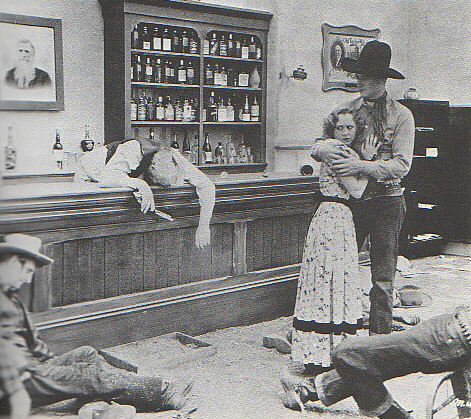

John Wayne made dozens of B Westerns for major and minor studios in the '30s before he hit it big with Stagecoach in 1939 for RKO. This film was made for Monogram, a minor studio, and directed by Harry Fraser, a quirky director who spent his entire career toiling over B movies for long-forgotten Poverty Row studios. Working at a studio like Monogram would be considered the start of a downward slide for most directors; for Fraser it was a step up the career ladder, and he was ready for it. This could well be called one of, if not the first, gothic Westerns; such things simply did not exist in 1934. This kind of movie wouldn't have been made at any of the big studios, but the independents could get away with a lot of things the majors couldn't (and wouldn't) do. This is an extremely offbeat, well done little film, not at all like Wayne's other westerns of the period.
It's eerie, atmospheric and has an especially shocking (for the time) opening scene. Randy (Wayne) rides into town after a long, dry trip and stops by the local saloon to wet his whistle. As he approaches it, he hears the tinkle of a piano coming from inside. Entering the establishment, however, he's greeted by a grisly sight: the piano is a player piano running by itself, and there are dead bodies lying everywhere.
Wayne is accused of murder and attempted robbery but is released from jail by the trusting heroine, Sally Rogers (Alberta Vaughn), to sort out the real villains, a gang led by a mysterious figure who spends most of the time masquerading as one of the townsfolk, Matt the Mute. Played by George Hayes, this cunning character has padded his figure to pass himself off as a hunchback and is prone to impede the progress of the film no end by laboriously writing out messages that, except for his disguise, he could perfectly well speak. This is the same Greorge Hayes that was to become the comic sidekick to Hopalong Cassidy and Roy Rogers known as Gabby Hayes.
I like the moment when Wayne stumbles into the secret lair of the villains behind a waterfall. They want to know how he got there. "I fell in!" snaps the soaking-wet Wayne, as though daring any of them to make something out of it. Who does he work for, they ask. "Nobody," he replies , adding (to justify the film's title ) "I ride alone." Wayne's walk in this film has a lazy air of increasing confidence, and he is seen twirling his six-shooter with professional ease before taking aim at the portrait on a wanted poster and shooting out the eyes to demonstrate his marksmanship. Learning of the boss' secret identity by comparing handwritten notes, he has a plan that will enable the Sheriff to round them all up.
| Randy Bowers | John Wayne | |
| Sally Rogers | Alberta Vaughn | |
| Marvin Black, alias Matt Matthews/Matt the Mute | George Hayes | |
| Henchman Spike | Yakima Canutt | |
| Henchman Tommy | Tommy Coats | |
| Henchman | Herman Hack | |
| Henchman | Tex Palmer | |
| Sheriff | Earl Dwire | |
| Deputy Al | Tex Phelps | |
| Deputy | Arthur Ortego | |
| Deputy | Mack V. Wright | |
| Ed Rogers | Horace B. Carpenter | |
| Murder Victim | Murdock MacQuarrie | |
| Kidnapper | Perry Murdock | |
Released June 5, 1934 U.S; April 8, 1935 G.B.

Your comments or suggestions are welcome and encouraged.
| Search this site | What's new | Site map |